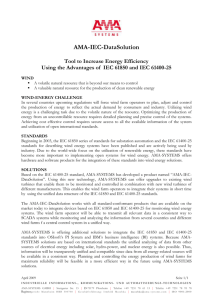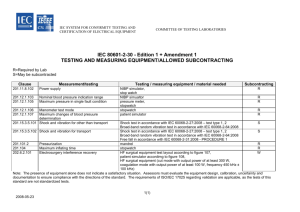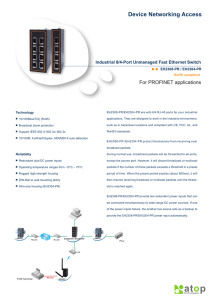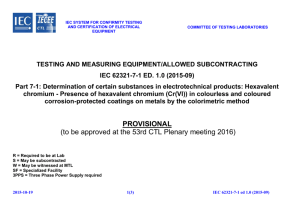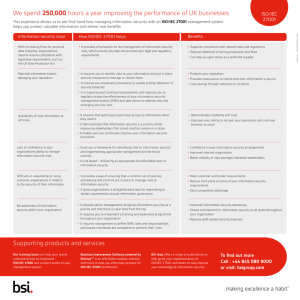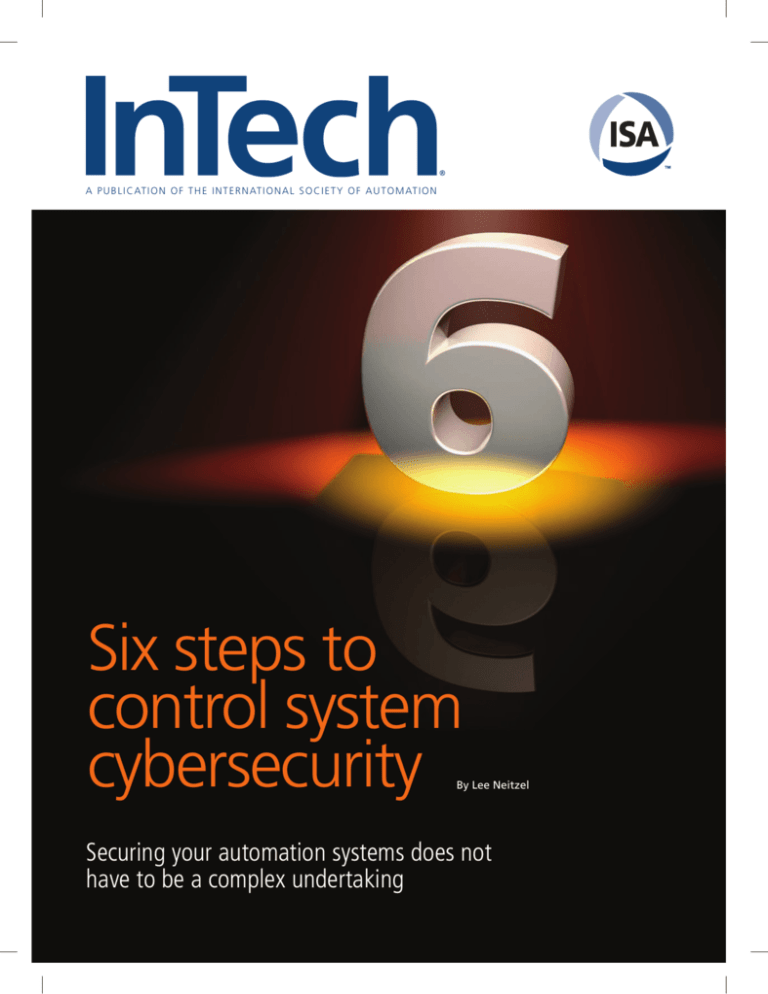
A P u b l i c at i o n o f t h e I n t e r n at i o n a l S o c i e t y o f A u t o m at i o n
Six steps to
control system
cybersecurity
By Lee Neitzel
Securing your automation systems does not
have to be a complex undertaking
special section: security
Fast Forward
l
l
l
I
f you are like most process automation professionals, you are aware that your automation
systems are not as secure as they should be, and
you would like to make improvements. But you are
somewhat confused by all the industry chatter regarding security and standards, and you are looking for a clear path toward improvement, minus the
hype and scare tactics.
The main objective of control system security is to
keep the plant safe and to keep production running. In
contrast, IT security focuses on protecting data, such
as credit card numbers, from being stolen. The primary
threat to both of these goals is the infiltration of malicious software into the system.
Malicious software normally infects a system by
1) using file transfer mechanisms, such as file shares
and the file transfer protocol (FTP), 2) exploiting vulnerabilities in network-facing software that allow
code to be injected into the system, and 3) the automatic copying of files from portable media, such as
USB sticks, CDs, DVDs, and cell phones to the system.
There are six steps that you need to address this
threat. These steps are taken from emerging NIST,
ISA, and industrial cybersecurity standards that are
being integrated into a single international IEC standard [IEC 62443]. They define not only the security
mechanisms needed in a control system, but also
the supplier capabilities needed to harden the system at the site. In addition, certification programs
are now in place to certify suppliers against these
standards. Standards activities are summarized after
the steps to security are described.
Before beginning these steps, you should make sure
that you have security policies for the control system.
IT departments all have security policies that you can
review if you do not have one yet for your control system. Your security policies should support each of the
steps below and be geared toward keeping unauthorized software off your system.
six steps to security
The steps that follow reinforce the concept that security cannot be accomplished just by buying a control
system with the right security features. They emphasize that security is just as much a process as it is
technology. Following these steps not only addresses
The main goal of automation system security is maintaining safety
and availability, primarily by preventing the intrusion of foreign software, such as malware and viruses.
This goal can be attained by following the six steps derived from
converging ISA/IEC/WIB standards and detailed in this article.
End users can ease the hardening of their systems during implementation and on-going maintenance by partnering with certified
hardware vendors, software suppliers, and service providers.
the malicious code threat, but also other attacks that
threaten control systems.
These steps can be implemented in an evolutionary fashion so that security improves over time. The
evolution of security is defined by a maturity model
specified in the IEC standard. It should encourage
you to start down the path to security, rather than
thinking security is just too ominous and complicated to address. Adoption of these new security
standards is going to be like the painful adoption of
seatbelts that we all went through, from initial denial
of the need to finally recognizing the benefits.
step 1: network security perimeters
Step 1 involves establishing network security perimeters to restrict access points where foreign software
can enter the automation system. As shown on the
following page, in a typical control system plant/enterprise networks are at Level 3 and above in the Purdue model, while the control system networks and
buses are at Level 2 and below.
Firewalls are used to segment the control system
internally and to isolate it from Level 3 and other
external networks. You must ensure that all traffic
to/from the control system is encrypted and passes through at least one firewall. Further, under no
circumstances should any Level 2 workstation be
granted direct access to the Internet, or have an IP
address that allows it to be directly accessed from
the Internet.
Within the control system, firewalls should be
used to protect controllers, wireless device networks,
and SIS networks from Level 2 workstations. In addition, switches with lockable ports should be used
to prevent unauthorized devices from connecting to
the control system. These firewalls and switches, in
conjunction with the Level 3/Level 2 firewalls, create a layering of security perimeters with the lowest
degree of trust attributed to Level 3 and the highest
level granted to Level 1.
Components that are not as critical to safety and
availability, such as historians and data servers,
should be installed at an upper level in the hierarchy,
with less protection, but correspondingly more access, so that plant personnel can view data and make
changes as needed.
special section: security
regular reboot of the workstation to protect against memory-only infections. Some of
the more sophisticated attacks involve installing memory resident malware that is
hard to detect. Workstations
that are targets for this type of
attack are those that run 24/7.
Rebooting these workstations
when time permits will remove this type of malware.
step 3: user account management
Once the firewalls and smart switches are installed, they must be maintained throughout the lifetime of the
system to keep their effectiveness from
degrading. Firewall rules must be kept
current to reflect changes to IT and
control systems and to protect against
newly discovered threats. Unused
switch ports must be regularly checked
to make sure they are still locked.
step 2: Workstation hardening
Step 2 involves hardening control system
workstations to make it more difficult for
malicious software to find a way into the
system. Five primary hardening activities should be performed. First, the Center for Internet Security (CIS) hardening
template should be applied to lock down
the workstation’s security policies.
Second, these workstations should be
dedicated to operator and engineering
functions, and, as such, all applications,
services, and ports that are not needed
to support these functions should be
removed or disabled to prevent vulnerabilities they may have (known or unknown) from being exploited.
Third, anti-virus software should be
installed to detect and delete known
malware before it can infect the workstation. In addition, virus definition files
should be kept up to date to keep up
with new viruses that are circulating.
Fourth, the file system should be
configured to permit only authorized
users to access sensitive files. The default, unfortunately, is to allow users
with administrator privileges to access
all files on the workstation. These users
should be carefully analyzed, and they
should be granted access only to files/
directories that they need.
Fifth, USB, CD, and DVD drives should
Step 3 involves managing user
accounts. Users should be
given only the privileges that
they need, and their passwords
should be sufficiently long and
require the use of a combination
of three of the following four:
upper and lower case letters,
numbers, and special characters. Granting a limited set of privileges should reduce the ability of foreign software that
has infected a user’s program from using
elevated privileges to perform some malicious act – a very common technique
used by malware.
Using complex passwords makes it
significantly harder for hackers to guess
passwords or to reverse engineer password files should they gain access to
them. In addition, password policies
should be set to cause passwords to expire regularly and to prevent the reuse
of previous passwords, generally the last
three. Protecting passwords not only
protects against malware gaining access
using complex passwords makes it significantly harder for
hackers to guess passwords or to reverse engineer password
files should they gain access to them.
be locked down when not used for authorized purposes. Additionally, users
should be reminded that using portable
media is a common way of infecting
a system. It is not unheard of for an attacker to drop infected USB sticks in the
parking lot and hope someone will pick
one up and plug it into the workstation.
Finally, these hardening activities
can be supplemented by one more:
to the system, but also protects against
hackers logging onto the system.
If malware is running in a user’s program and is able to acquire the password of an administrator, it may use
that password to elevate privileges of
that program or to start another program using administrator credentials.
These techniques are commonly used
by malware to elevate its privileges.
special section: security
step 4: security updates
Step 4 is making sure that security updates (patches) for both operating system and control system software are
kept up-to-date. These updates remove
vulnerabilities that can be exploited
to infect the software containing the
vulnerability. Free tools can be found
on the Internet that allow hackers to
search a workstation for vulnerabilities
and then automatically inject malicious software that provides cmd.exe
shell access to the workstation or that
allows custom hacker code to be downloaded to the workstation and run.
Of course, updates should be approved
for the workstation so they do not disrupt
workstation software. Certified suppliers are required to validate all security
patches for operation on their systems.
step 5: Backup and recovery
Step 5 involves implementing a backup
and recovery plan. An effective backup
and recovery plan allows an infected system to have its configuration data and
software restored to an uninfected state.
Certified suppliers are required to have a
backup and recovery strategy that specifically recommends when and how to
recover a system to a stable state even if
there is no evidence of infection. This is
important since sophisticated malware
often hides itself from detection and can
sit dormant until the right time.
step 6: security monitoring
and risk assessment
Step 6 involves monitoring the system
for suspicious activity and performing
risk assessments. Security monitoring
packages examine logs of workstations,
firewalls, switches, and devices for evidence of foreign software. Some monitoring packages inspect network traffic,
as well as processor and memory usage,
looking for anomalies. In the absence
of automated monitoring packages,
manual review of event and network
traffic logs should be performed to look
for suspicious activity, such as an unexpected increase in network traffic, particularly at odd hours.
Risk assessments should be performed during initial design, prior to
handover, and during the maintenance
cycle of the system to ensure that
changes to the system have not been
introduced that weaken security. Actions taken after a risk assessment may
include new firewall rules, new switch
ports to lockdown, stronger password
policies, removal of unused software
programs, and better procedures for
managing the connection of external
devices like USB memory sticks.
the industry is converging
on the iec 62433 standard.
converging standards
simplify compliance
In the past, a number of different groups
worked independently to formulate security standards, but these groups have
come together to create one common
standard, which will greatly simplify
implementation and compliance. NIST
is also participating in this effort, whose
participation has been reinforced by the
12 February 2013 Executive Order entitled “Improving Critical Infrastructure
Cybersecurity.”
ISA created the ISA99 project, Industrial Automation and Control System
Security, ten years ago to develop a
comprehensive suite of security standards for the automation industry.
Their work has been submitted for IEC
standardization as IEC 62443.
In parallel, the International Instrument Users’ Association, referred to as
the WIB after its original Dutch name,
created a security standard for best
practices of control system suppliers.
This standard complements the ISA-99
suite and has also been accepted for
standardization within the ISA-99/IEC
62443 series.
Still in parallel, two device level security certification standards have
been developed: ISA SecureDevice and
Wurldtech’s Achilles Communication
Certification. These standards are also
being integrated into the ISA-99 IEC
62443 series.
In summary, the industry is converging on the IEC 62433 standard. This
standard will provide a very comprehensive set of standards for industrial
cybersecurity that includes standards
for organizations, control systems,
components, and deployment/maintenance. Existing certification programs
will continue, but these will reference
the IEC 62443 standards rather than
their own separate specifications.
conclusion
Industrial security is more than just
hardware and software. Project and
support personnel have a responsibility to promote security awareness at the
site and to ensure that they are capable
of hardening a control system according to the security policies of the site.
Emerging standards, converging
within IEC 62443, provide requirements
for manufacturers of control systems/
components and for suppliers of deployment and maintenance services.
Within the context of IEC 62443, security programs go through an evolutionary process that allows them to mature.
Finally, a number of suppliers have
achieved certifications that reflect their
commitment to control system security.
The use of certified suppliers and service providers can cut costs, reduce risk,
and quicken compliance – both during
implementation and over the entire life
cycle of the automation system.
aBoUt tHE aUtHor
lee neitzel, senior engineer at emerson
Process management in Austin, texas,
has been involved in security and network
standards for more than 25 years, having
worked on ieee 802, fDDi, fieldbus foundation, and oPc standards. he is currently
the iec project leader for integrating the
Wib “Process control Domain – Security
requirements for Vendors” specification
into the iec 62443 and the iSA-99 security standards.
Resources
Defense in Depth
www.isa.org/link/DefenseinDepth
Control Network Secure Connectivity
Simplified
www.isa.org/link/controlnetwork
ISA99 examines standards’ strength
against Stuxnet-like attacks
www.isa.org/link/ISA99
Reprinted with permission from InTech, May/June 2013. On the Web at www.isa.org.
© ISA Services, inc. All Rights Reserved. Foster Printing Service: 866-879-9144, www.marketingreprints.com.



